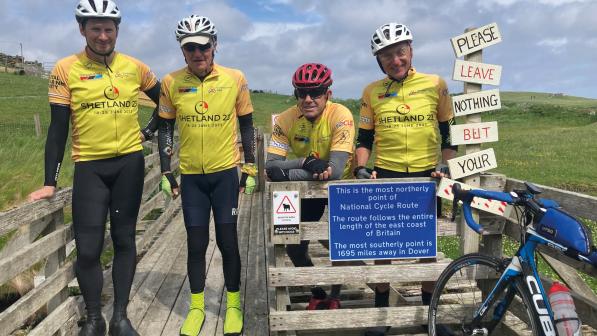Cycling in the Scottish Islands

Island-hopping by touring bike through the Outer Hebrides, Orkneys or Shetland is quite unlike anything else in Britain – they’re also quite unlike each other. And they’re only three highlights among Scotland’s wonderful islands.
The Orkneys, a tranquil collection of mostly low-lying islands (apart from rocky Hoy) linked by ferries, can feel surprisingly rural and cosy. Stone Age villages and other evidence of its many thousands of years of habitation attest to that. Kirkwall and Stromness are splendidly characterful places, and cycling out south takes you across some extraordinary causeways – the Churchill Barriers – and to the stirring gem of the Italian Chapel.
Shetland, way up north at the limit of NCN1, is something different. The windswept, austere, far-flung islands are a place on the edge, of seabirds, crashing seas, half-mystic Norse footprints, hardy communities and yes, tiny horses. Few cyclists venture this far but the rewards are unique. Unst is the furthest north you can cycle in the UK; in midsummer it never gets properly dark.
The Outer Hebrides, probably accessed by the ferry from Ullapool to Stornaway, are a thrilling place to tour, especially for independent cycle-campers. The landscapes of Lewis and Harris look lunar and airless in photos, but feel less so if you’re cycling into a headwind. The ‘Golden Road’ south and then a ferry take you to Uist and Benbecula, whose fractal landscapes are linked by causeways all down to Eriskay, then (with another short ferry) to Vatersay. It’s all unforgettable stuff.
A network of ferries can take you to and round the Inner Hebrides, notably Jura and neighbouring Islay, the whisky island. All make for great exploratory touring.
Easily accessible from Glasgow, the Isle of Arran is made for cycle touring: a kind of Scotland in miniature, with its mountainous northern half and forested, hilly southern half, and inevitable distillery.
Cycling groups and clubs the Scottish Islands
Embark Community Cycle Group (Lewis and Harris)
http://www.cyclinguk.org/local-groups/embark-community-cycle-group
What to take with you on your ride
The only thing you really need for cycling is a bike. And maybe a phone, and credit card: in Britain you’re only a call away from any service you might need.
But unless money is no object, it’s wise to take a few things with you on a day ride. A saddlebag or rear rack and panniers are best for carrying stuff. A front basket is second best. A rucksack is third best. Your sweaty back will soon tell you why.
Cycling short distances in jeans and t-shirt is fine, but on a long or strenuous ride – over ten miles say, or in hills – those jeans will rub and the t-shirt will get damp and clingy. Shorts or, yes, lycra leggings and padded shorts will be much comfier, and merino or polyester cycling tops wick away the sweat, keeping you dry and comfy. (They don’t have to be lurid colours.)
If rain’s in the air, pack a rainproof top. If it might turn chilly, take a fleece or warm top. But the thing you’re most likely to forget is the sunblock.
It’s remarkable how often you enjoy being out on the bike so much that you suddenly realise it’s getting dark. So take lights (which are legally required at night). They’re price of a sandwich, take no space, are easy to put on thanks to tool-free plastic clips, and the batteries last for ever.
Take a puncture repair kit (with tyre levers) and pump. Make sure it fits your valves, which will be either ‘Presta’ or ‘Schraeder’ – realising they don’t match is a very common roadside discovery! Carrying a spare inner tube (make sure it matches your tyre size) makes puncture repair much easier: mend the old one back at home. If you do get in trouble, some kindly passing cyclist will probably stop to help.
Using a helmet is a personal choice – they’re not legally required.
Cycling makes you thirsty, so take lots of water. Long-distance riders talk about ‘the bonk’ – a sudden loss of energy rendering you almost stationary. It’s miraculously and instantly cured by eating something sweet. On short rides you’re unlikely to run out of energy, but just in case, take a snack like flapjack, banana, chocolate or jelly babies.
Taking a packed lunch or picnic will save you money, though that hot drink and cake in a cosy cafe could yet prove very tempting!
Your phone GPS could be invaluable for showing where you are when lost; you can download free detailed UK maps and GPS software before your trip.
Paper maps are still useful, though, so take one: no power source or wifi signal required, and they’re great for suggesting possibilities or changes of plan.

